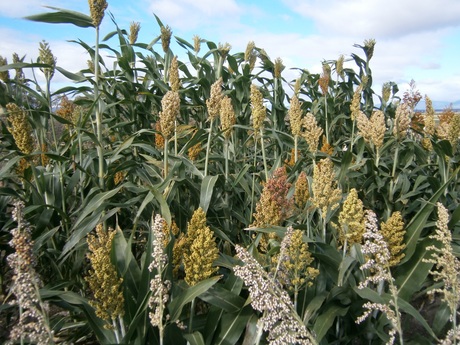Breeding sorghum to feed the world

A whole genome resequencing project that is part of efforts to improve drought tolerance and nutritional quality in sorghum has revealed a high level of genetic diversity in this cultivated crop.
A consortium of Australian and Chinese researchers resequenced 44 sorghum lines spanning various subgroups and geographic origins to discover the previously unrealised genetic variation.
Sorghum is a drought-tolerant crop and the staple food for about half a billion people in sub-Saharan Africa and Asia. It is also an important source of animal feed worldwide and is emerging as a potentially valuable biofuel crop.
Due to its ability to adapt to heat and drought, sorghum is expected to play an increasingly important role in agriculture and meeting world food demand in the face of climate change, land degradation and increasing water scarcity.
Dr David Jordan, from Queensland Alliance for Agriculture and Food Innovation (QAAFI), and colleagues identified 725 candidate genes for domestication and crop improvement by analysing the divergence between wild and cultivated sorghums, and report 285 domestication genes that may play a role in sorghum productivity and other traits relevant to agricultural economics.
Dr Jordan leads Australia’s national sorghum genetic improvement program and is using this information to breed improved sorghum varieties for Australia and Africa.
“Five years ago, we would not have believed that we would have access to this sort of detailed understanding of sorghum genes,” Dr Jordan said.
Breeding improved varieties
The study’s lead author, Dr Emma Mace from the Queensland Department of Agriculture, Fisheries and Forestry (DAFF), said the sorghum sequence information they had generated would provide the best genomic information to date on this important crop.
“What has been poorly understood, until now,” Dr Mace said, “is the nature of genetic diversity at the genomic sequence level.”
Armed with this data, researchers can now examine variation in specific genes and use this information to breed improved sorghum varieties.
“Our study revealed a dramatic reduction in the diversity of modern varieties compared to the wild ancestors,” Dr Mace said.
“It really highlights the exciting opportunities sorghum plant breeders have to make use of previously untapped variation.”
This resource is not just important for sorghum, it will allow for genetic comparison between other cereal crops. Cereal crops share most of their genes in common so an understanding of drought mechanisms in one crop can be used to improve drought adaptation in other crops such as wheat, maize and rice.
Understanding grain quality
The results of this study have already had an impact, allowing scientists to focus on improving the quality and drought resistance of sorghum.
“Already we are using the information in our GRDC [Grains Research and Development Corporation]-funded pre-breeding program and it will play a key part in a new project to identify genes for drought tolerance funded by the Bill & Melinda Gates Foundation,” said Dr Jordan.
Another researcher involved in the study, Professor Ian Godwin at the University of Queensland, leads a research group focused on improving the quality of sorghum for human and animal nutrition.
Data from this study contributed to research published in Nature Communications earlier this year in which the agriculture scientists identified a gene that improves the food value of sorghum.
“Having access to these sequences makes it much easier to understand difficult traits such as grain quality,” Professor Godwin said.
“While an important staple, sorghum’s low digestibility presents a fundamental challenge for its utility as a food source and this research could provide new options for securing food supplies in Africa and Asia.”
The project was funded by the Australian Research Council and Australian farmers through the GRDC.
The work was published in Nature Communications.
Mini lung organoids could help test new treatments
Scientists have developed a simple method for automated the manufacturing of lung organoids...
Clogged 'drains' in the brain an early sign of Alzheimer’s
'Drains' in the brain, responsible for clearing toxic waste in the organ, tend to get...
World's oldest known RNA extracted from woolly mammoth
The RNA sequences are understood to be the oldest ever recovered, coming from mammoth tissue...





